#generative AI for customer support
Explore tagged Tumblr posts
Text
How Can Generative AI Enhance Your Business's Organisational and Operational Processes
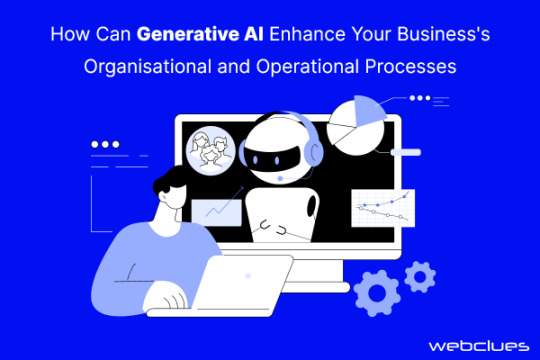
Experience the future of business transformation with Generative AI. From customer support to content creation, sales optimization, and HR process automation, this cutting-edge technology is your key to enhanced efficiency and innovation. Learn how Generative AI can automate and elevate your operations while delivering personalized experiences and data-driven insights.
At Webclues Infotech, we're your partners in harnessing the true potential of Generative AI. Join us in this technological revolution and take your business to new heights in a fast-paced world. Read the blog for more insights.
#generative AI for customer support#Generative AI for sales#generative AI for marketing#Generating AI for HR#generative AI services#Generative AI chatbots#generative ai in business#business use cases for generative AI
0 notes
Text
i know it would only be an unnecessary pain in the ass for him if i did but it does bother me not to respond like THANK YOU SO MUCH to my gp's messages to me through the healthcare online portal thing. he has a tendency to sit and answer messages and prescription refill requests late as hell in the evening because that's when he finally has the time and it feels so wrong to not reply even if it's entirely unnecessary and he neither expects nor wants that
#i feel the same about customer support emails 😭#like they don't need an additional email of me thanking them for their help that's only gonna clog up their inbox even further#but it feels so rude lmao#i have thanked tumblr and irl merch support a few times though they're just so lovely to me always#lovely to everyone i assume but i have a tendency to write the most chaotic and desperate apologetic sounding emails because the concept of#emails in general stresses me the fuck out And i feel bad for bothering them even if i know that's their job#so they get this longass paragraph of me rambling that's definitely far more annoying than just a simple question#but the responses are so cute lol they always start off replying to all the off topic shit in a very personal way before getting into the#actual issue at hand#shoutout to the adobe support guy who apologised to me six times over the company's rules about older versions of their software#ur a real one#i will die on the hill that adobe is evil but their customer support people are extremely nice#and no doubt underpaid#nice once you finally get past their fuckass ai bot and get to talk to an actual person that is. nightmare#again i know it's a job but i've had plenty of unpleasant customer support interactions so the extra lovely ones make me smile :)
32 notes
·
View notes
Text
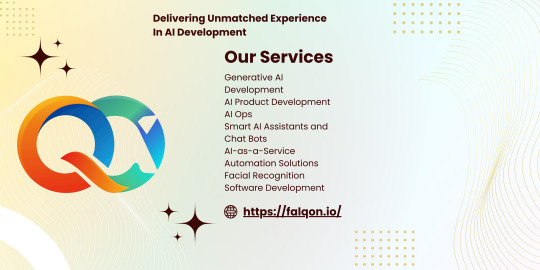
artificial intelligence| ai development companies| ai in business| ai for business automation| ai development| artificial intelligence ai| ai technology| ai companies| ai developers| ai intelligence| generative ai| ai software development| top ai companies| ai ops| ai software companies| companies that work on ai| artificial intelligence service providers in india| artificial intelligence companies| customer service ai| ai model| leading ai companies| ai in customer support| ai solutions for small business| ai for business book| basic knowledge for artificial intelligence| matching in artificial intelligence|
#artificial intelligence#ai development companies#ai in business#ai for business automation#ai development#artificial intelligence ai#ai technology#ai companies#ai developers#ai intelligence#generative ai#ai software development#top ai companies#ai ops#ai software companies#companies that work on ai#artificial intelligence service providers in india#artificial intelligence companies#customer service ai#ai model#leading ai companies#ai in customer support#ai solutions for small business#ai for business book#basic knowledge for artificial intelligence#matching in artificial intelligence
2 notes
·
View notes
Text
AI-driven localization is changing global marketing by enhancing cultural relevance and expanding brand reach in diverse markets worldwide.
#AI For Multilingual Customer Support#AI-Generated Localization#AI-Powered Localization#Generative AI#Generative AI For Businesses#Hyper-Personalized Marketing
0 notes
Text
AI-driven localization is changing global marketing by enhancing cultural relevance and expanding brand reach in diverse markets worldwide.
#AI For Multilingual Customer Support#AI-Generated Localization#AI-Powered Localization#Generative AI#Generative AI For Businesses#Hyper-Personalized Marketing
0 notes
Text
Why Customer Service Is Heading Towards Generative AI Support

Businesses are under growing pressure to provide quicker, more effective, and more individualized customer service in the fast-paced digital world of today. Although somewhat successful, traditional customer service approaches frequently lack scalability and round-the-clock accessibility. Here comes generative AI customer support, a ground-breaking development that is completely changing the way companies communicate with their clients.
Generative AI Customer Support: What Is It?
Large language models (LLMs) and other sophisticated artificial intelligence models are used in generative AI customer assistance to comprehend, produce, and react to consumer queries instantly. Generative AI can answer complicated queries, learn from interactions, and continuously improve its performance, in contrast to simple chatbots that follow preset scripts.
The Main Advantages of Generative AI for Customer Support
Constant Accessibility
AI that is generative never sleeps. AI-powered systems can deliver reliable, accurate answers instantly, regardless of the time of day—for example, a client question at 3 AM or during a period of high traffic.
Scalability Without Expense
It can be expensive and time-consuming to hire and train human agents to handle changing client expectations. Businesses can manage thousands of inquiries at once with generative AI customer assistance without sacrificing quality or requiring more staff.
Quick and Precise Reactions
Generative AI responds with contextually relevant and customized solutions based on natural language understanding (NLU) and real-time learning capabilities. This improves customer satisfaction and drastically cuts down on resolution time.
Support for Multiple Languages
Multilingualism is necessary to serve a worldwide clientele. The multilingual communication capabilities of generative AI guarantee that your help is extensive and inclusive.
Reduced Operating Expenses
Businesses can drastically reduce customer support expenses by automating routine and high-volume questions, freeing up people for innovation or high-priority problems.
Use Case Emphasis: Botric.ai
This change is being led by platforms such as Botric.ai. Botric uses state-of-the-art generative AI to develop intelligent, smooth customer service experiences that improve customer happiness and lessen operational load. Their AI assistance solutions are adaptable, simple to integrate, and always changing, which makes them a great partner for companies of all kinds.
Why the Future Is in Generative AI
The instruments we employ to meet client expectations must change along with them. The next logical step in the growth of customer service is generative AI customer assistance, not just a fad. Generative AI is raising the bar for consumer engagement by understanding context, personalizing responses, and learning continually.
Businesses who use platforms like Botric.ai to adopt this technology early on stand to benefit greatly from a competitive advantage.
In conclusion,
intelligent, scalable, and human-like automation is the way of the future for customer support. All of this and more is provided by generative AI customer assistance, which revolutionizes the way companies interact with their clients. Don't wait to adjust; use Botric.ai to discover the potential of AI-powered customer service right now.
0 notes
Text
How AI Is Revolutionizing Contact Centers in 2025
As contact centers evolve from reactive customer service hubs to proactive experience engines, artificial intelligence (AI) has emerged as the cornerstone of this transformation. In 2025, modern contact center architectures are being redefined through AI-based technologies that streamline operations, enhance customer satisfaction, and drive measurable business outcomes.
This article takes a technical deep dive into the AI-powered components transforming contact centers—from natural language models and intelligent routing to real-time analytics and automation frameworks.
1. AI Architecture in Modern Contact Centers
At the core of today’s AI-based contact centers is a modular, cloud-native architecture. This typically consists of:
NLP and ASR engines (e.g., Google Dialogflow, AWS Lex, OpenAI Whisper)
Real-time data pipelines for event streaming (e.g., Apache Kafka, Amazon Kinesis)
Machine Learning Models for intent classification, sentiment analysis, and next-best-action
RPA (Robotic Process Automation) for back-office task automation
CDP/CRM Integration to access customer profiles and journey data
Omnichannel orchestration layer that ensures consistent CX across chat, voice, email, and social
These components are containerized (via Kubernetes) and deployed via CI/CD pipelines, enabling rapid iteration and scalability.
2. Conversational AI and Natural Language Understanding
The most visible face of AI in contact centers is the conversational interface—delivered via AI-powered voice bots and chatbots.
Key Technologies:
Automatic Speech Recognition (ASR): Converts spoken input to text in real time. Example: OpenAI Whisper, Deepgram, Google Cloud Speech-to-Text.
Natural Language Understanding (NLU): Determines intent and entities from user input. Typically fine-tuned BERT or LLaMA models power these layers.
Dialog Management: Manages context-aware conversations using finite state machines or transformer-based dialog engines.
Natural Language Generation (NLG): Generates dynamic responses based on context. GPT-based models (e.g., GPT-4) are increasingly embedded for open-ended interactions.
Architecture Snapshot:
plaintext
CopyEdit
Customer Input (Voice/Text)
↓
ASR Engine (if voice)
↓
NLU Engine → Intent Classification + Entity Recognition
↓
Dialog Manager → Context State
↓
NLG Engine → Response Generation
↓
Omnichannel Delivery Layer
These AI systems are often deployed on low-latency, edge-compute infrastructure to minimize delay and improve UX.
3. AI-Augmented Agent Assist
AI doesn’t only serve customers—it empowers human agents as well.
Features:
Real-Time Transcription: Streaming STT pipelines provide transcripts as the customer speaks.
Sentiment Analysis: Transformers and CNNs trained on customer service data flag negative sentiment or stress cues.
Contextual Suggestions: Based on historical data, ML models suggest actions or FAQ snippets.
Auto-Summarization: Post-call summaries are generated using abstractive summarization models (e.g., PEGASUS, BART).
Technical Workflow:
Voice input transcribed → parsed by NLP engine
Real-time context is compared with knowledge base (vector similarity via FAISS or Pinecone)
Agent UI receives predictive suggestions via API push
4. Intelligent Call Routing and Queuing
AI-based routing uses predictive analytics and reinforcement learning (RL) to dynamically assign incoming interactions.
Routing Criteria:
Customer intent + sentiment
Agent skill level and availability
Predicted handle time (via regression models)
Customer lifetime value (CLV)
Model Stack:
Intent Detection: Multi-label classifiers (e.g., fine-tuned RoBERTa)
Queue Prediction: Time-series forecasting (e.g., Prophet, LSTM)
RL-based Routing: Models trained via Q-learning or Proximal Policy Optimization (PPO) to optimize wait time vs. resolution rate
5. Knowledge Mining and Retrieval-Augmented Generation (RAG)
Large contact centers manage thousands of documents, SOPs, and product manuals. AI facilitates rapid knowledge access through:
Vector Embedding of documents (e.g., using OpenAI, Cohere, or Hugging Face models)
Retrieval-Augmented Generation (RAG): Combines dense retrieval with LLMs for grounded responses
Semantic Search: Replaces keyword-based search with intent-aware queries
This enables agents and bots to answer complex questions with dynamic, accurate information.
6. Customer Journey Analytics and Predictive Modeling
AI enables real-time customer journey mapping and predictive support.
Key ML Models:
Churn Prediction: Gradient Boosted Trees (XGBoost, LightGBM)
Propensity Modeling: Logistic regression and deep neural networks to predict upsell potential
Anomaly Detection: Autoencoders flag unusual user behavior or possible fraud
Streaming Frameworks:
Apache Kafka / Flink / Spark Streaming for ingesting and processing customer signals (page views, clicks, call events) in real time
These insights are visualized through BI dashboards or fed back into orchestration engines to trigger proactive interventions.
7. Automation & RPA Integration
Routine post-call processes like updating CRMs, issuing refunds, or sending emails are handled via AI + RPA integration.
Tools:
UiPath, Automation Anywhere, Microsoft Power Automate
Workflows triggered via APIs or event listeners (e.g., on call disposition)
AI models can determine intent, then trigger the appropriate bot to complete the action in backend systems (ERP, CRM, databases)
8. Security, Compliance, and Ethical AI
As AI handles more sensitive data, contact centers embed security at multiple levels:
Voice biometrics for authentication (e.g., Nuance, Pindrop)
PII Redaction via entity recognition models
Audit Trails of AI decisions for compliance (especially in finance/healthcare)
Bias Monitoring Pipelines to detect model drift or demographic skew
Data governance frameworks like ISO 27001, GDPR, and SOC 2 compliance are standard in enterprise AI deployments.
Final Thoughts
AI in 2025 has moved far beyond simple automation. It now orchestrates entire contact center ecosystems—powering conversational agents, augmenting human reps, automating back-office workflows, and delivering predictive intelligence in real time.
The technical stack is increasingly cloud-native, model-driven, and infused with real-time analytics. For engineering teams, the focus is now on building scalable, secure, and ethical AI infrastructures that deliver measurable impact across customer satisfaction, cost savings, and employee productivity.
As AI models continue to advance, contact centers will evolve into fully adaptive systems, capable of learning, optimizing, and personalizing in real time. The revolution is already here—and it's deeply technical.
#AI-based contact center#conversational AI in contact centers#natural language processing (NLP)#virtual agents for customer service#real-time sentiment analysis#AI agent assist tools#speech-to-text AI#AI-powered chatbots#contact center automation#AI in customer support#omnichannel AI solutions#AI for customer experience#predictive analytics contact center#retrieval-augmented generation (RAG)#voice biometrics security#AI-powered knowledge base#machine learning contact center#robotic process automation (RPA)#AI customer journey analytics
0 notes
Text
Maybe we shouldn't call AI artificial intelligence but artificial imposter.
#not hating on ALL AI btw#just the art generators#(and by art I mean all kinds of art not just paintings)#also spam bot AIs who are programmed to rage bait and spread false information#custom support AI and google helpers I am neutral about#they are like little creatures who are trying but not fully understand your language I wouldn't trust with important stuff#(some of them are just fancy text searches that can chat with you)#they could become helpful if they get better. at least better than whatever the fuck search engines are doing nowadays
0 notes
Text
Boost Revenue with AI: How Automated Chatbots Turn Leads into Paying Customers
Boost Revenue with AI How Automated Chatbots Turn Leads into Paying Customers Imagine having a salesperson that never sleeps, never gets tired, and never drops the ball on follow-ups. Sounds too good to be true? Not anymore. With AI-powered chatbots, you can automate lead nurturing, handle objections, and close deals 24/7, all without lifting a finger. This isn’t about replacing human…
#AI appointment booking#AI chat marketing#AI chatbot analytics#AI chatbot for conversions#AI chatbot lead magnet#AI chatbot lead qualification#AI chatbot personalization#AI chatbots for sales#AI chatbots for small business#AI conversational AI for sales#AI conversational marketing#AI customer engagement#AI customer interaction#AI follow-up automation#AI for B2B sales#AI for closing deals#AI for customer support#AI for inbound sales#AI for lead engagement#AI for real-time sales support#AI for service-based businesses#AI lead generation#AI messaging automation#AI sales assistant#AI sales automation#AI sales follow-ups#AI sales funnel optimization#AI virtual sales assistant#AI website chatbot#AI-driven customer retention
0 notes
Text


Dogwood Records 🎧
Have you ever wanted to own a record store? Now you can! Well, in game at least (lol). I always had this vision of what I wanted my store to look like- and I have finally created this set that kind of brought that vision to life. Dusty wooden furniture, neon lights, record players and records scattered everywhere were just some of the things I had in mind but I hope this set will bring you so much more.
The record covers WERE NOT ai generated! One half is by real life artists + a cartoonizing effect and Topaz Clean (a PS plugin) and the other half was purchased by me on Unsplash+: here is a detailed post on my blog with how I created them and with all the links to the albums and art.
To download everything and get some more info on the items + the monthly Patreon's gift set, CLICK HERE to visit my Patreon page (the set will be public on 4th May).

Fun fact: I wanted to add functionality to this set so the records can be sold & bought (when placed on the Stairway To Heaven retail shelf) at your small business (requires the Business & Hobbies EP)! Once your sim buys them, they can be found in the Household Inventory. What's a better b'day present for a sim than their favorite record? There's also a magazine/comic book rack so that your customers can entertain themselves while listening to their favorite artist. 🎵
Edit: removed the David Bowie swatch because I was not aware of the allegations surrounding him and I do not support anything of the sort.

Special thanks to peacemaker for the stunning wood textures; myshunosun, nucrests, helgatisha and trillyke for various textures + simlish graphics <3
8K notes
·
View notes
Text
Generative AI and Customer Experience: Enhancing Personalization and Engagement

Businesses today are always looking for fresh ways to boost customer engagement and satisfaction. Generative AI is emerging as a game-changer tool, reshaping how companies connect with their customers. Using AI, businesses can craft experiences that feel more personal and engaging resonating with customers like never before.
According to Statistaprojection, the Generative AI market will reach $36.06 billion in 2024, with a remarkable annual growth rate of 46.47%, hitting an impressive $356.10 billion by 2030.
Generative AI has many focuses in many domains and customer experience is one of them. AI has been a huge blessing to the customer experience domain. It helps in retaining the customers and giving them the best possible experience possible. The biggest chunk in the Generative AI initiative is customer experience, further there are revenue growth, cost optimization, business continuity and so on.
This blog dives into the whole criteria of generative AI in customer experience, how it creates a smooth procedure, and how its practical usage transforms customer interactions.
Key Takeaways:
Generative AI, a specialized branch of AI, focuses on generating unique content. It significantly enhances CX through improved personalization, engagement, and loyalty strategies.
With 73% of consumers desiring personalized treatment over feeling like just a statistic, generative AI meets these expectations by personalizing engagement through tailored offerings and predictive insights.
By enabling detailed customer segmentation and dynamic content creation, generative AI empowers businesses to forge lasting relationships with customers, making them feel valued.
In a recent Gartner webinar, 38% of executives cited retention as a primary goal for generative AI investment. Through automated feedback and fast customer support, businesses can build strong customer loyalty.
What is Generative AI Customer Experience?

Generative AI in customer experience is an innovative approach that uses AI-driven capabilities to elevate customer interactions and engagement. Unlike traditional methods with rigid, pre-set responses, generative AI dynamically generates personalized, context-sensitive content in real-time. This leads to more customized, adaptive experiences, driving stronger satisfaction and customer loyalty.
By examining customer data and identifying behavior patterns, generative AI crafts individualized marketing materials, product recommendations, and support solutions that resonate on a personal level. This technology transforms customer engagement, helping businesses not only enhance the quality of interactions but also scale their customer experience initiatives with greater efficiency. This level of personalized automation makes the customer journey smoother and more engaging, setting new standards for customer satisfaction.
How Generative AI Enhances Customer Experience?
Incorporating Generative AI into CX solutions accelerates response times, processes bulk queries, and improves accuracy, all while reducing training costs. This efficiency allows businesses to boost satisfaction and retain customers as loyal brand advocates. Key applications include:
Personalization

Around 66% of consumers prefer brands that know their preferences and make personalized recommendations. Generative AI empowers businesses to deliver these tailored experiences, as explained in the following points:
Customized Offerings
Recommender Systems: AI-driven recommendation engines apply collaborative and content-based filtering to curate relevant products or services. By evaluating browsing patterns and past purchases, these systems boost conversion potential with highly targeted suggestions.
Adaptive User Interfaces: Generative AI customizes user interfaces to align with individual habits and preferences. E-commerce platforms, for example, may reorganize categories or showcase frequently viewed items based on a user’s history, creating an intuitive browsing experience.
Tailored Product Design: Merging generative AI with 3D modeling enables customers to personalize products, such as custom clothing or phone cases. This feature enhances user satisfaction by allowing unique co-design options.
Personalized Content Creation: Advanced AI models analyze vast customer interaction data to generate specific, relevant content. This includes tailored product descriptions, emails, and social posts, which resonate more effectively with each customer’s interests.
Predictive Analysis

Customer Behavior Forecasting: By processing historical data, AI forecasts customer behaviors, including purchase likelihood and churn risk. This insight informs targeted retention strategies and optimizes engagement tactics.
Sentiment Analysis: Generative AI examines customer sentiments across channels, such as feedback or social media. This real-time sentiment insight helps businesses respond proactively, resolving issues and improving satisfaction.
Demand Forecasting: Generative AI assesses sales data and external trends, such as seasonality, to predict demand shifts. Anticipating these trends allows for effective inventory management and timely, relevant promotions.
Engagement
With 80% of customers viewing brand experiences as equally essential as products, generative AI supports enhanced customer engagement, as outlined below:
Customer Segmentation
Predictive Segmentation: Generative AI applies predictive analytics to categorize customers by interest, enabling timely and relevant interactions. This approach supports personalized offers and exclusive promotions that align with individual preferences.
Micro-Segmentation: Through advanced data analysis, generative AI detects subtle customer distinctions, driving precise micro-segmentation. This refined segmentation empowers businesses to deliver customized communications and products, elevating engagement.
Sentiment-based Segmentation: Using sentiment analysis, AI categorizes customers by emotional response, enabling proactive care for dissatisfied customers. Addressing these concerns promptly nurtures relationships and bolsters brand loyalty.
Content Creation

Dynamic Content Generation: Generative AI crafts real-time, responsive content tailored to customer preferences. For example, generative AI chatbots provide personalized, interactive responses, creating engaging service experiences.
User-Generated Content Enhancement: By analyzing and summarizing user-generated content, generative AI helps spotlight influential feedback. Highlighting this content builds trust and deepens customer engagement.
Interactive Content Experiences: AI creates immersive content, from quizzes to product demos, that captivates customers. These participatory experiences enhance engagement by inviting customers into a personalized journey.
A/B Testing and Optimization: AI supports A/B testing by generating and analyzing multiple content versions. This iterative process allows businesses to fine-tune content for optimal engagement and conversions.
Loyalty

With 1 in 3 customers ready to switch brands after a single poor experience, loyalty is a crucial yet challenging goal. Generative AI effectively reduces churn by enhancing customer loyalty through the following methods:
Automated Customer Surveys
Personalized Surveys: Generative AI crafts customized surveys tailored to each customer’s journey. These surveys encourage participation by making customers feel their individual experiences are valued, prompting more detailed feedback.
Real-Time Feedback Collection: AI-powered chatbots and virtual assistants capture immediate feedback during interactions, helping businesses show customers that their opinions are valued. This responsiveness reflects a brand’s commitment to continuous service improvement.
Customer Support
24/7 Availability: Generative AI-driven virtual assistants provide constant, round-the-clock support, ensuring customers receive help anytime they need it. This uninterrupted support builds trust, fostering a loyal customer base that knows help is always accessible.
Instant Responses: AI chatbots deliver immediate responses to queries, significantly reducing wait times and frustrations. Quick, reliable responses show customers their time is respected, reinforcing brand loyalty.
Consistent Support Quality: Generative AI ensures uniformity in support interactions by adhering to strict guidelines. This minimizes human error, assuring customers of high-quality, reliable assistance in every interaction.
Comprehensive Issue Resolution: Generative AI efficiently addresses a wide array of customer concerns, from simple FAQs to complex queries. By consistently resolving issues, businesses demonstrate dedication to customer satisfaction, reinforcing loyalty.
Types of Generative AI in Customer Experience

Generative AI for customer experience includes a suite of advanced technologies designed to elevate customer interaction, engagement, and satisfaction. Each type offers unique capabilities to refine and personalize customer experiences. Key types revolutionizing customer experience include.
Chatbots
Chatbots are one of the most common and powerful generative AI tools in the customer experience. These AI-powered virtual agents simulate human conversation, providing immediate, tailored responses to customer queries. Chatbots handle frequent customer questions, assist with product choices, and resolve service issues autonomously. Their role in customer service automation boosts both satisfaction and operational efficiency. Notably, the chatbot market for generative AI is projected to grow from USD 119.0 million in 2023 to around USD 1,223.6 million by 2033, with an impressive CAGR of 27% expected between 2024 and 2033.
Virtual Assistants
Virtual assistants advance the chatbot concept by offering more sophisticated support with personalized experiences. These AI-driven assistants remember context, learning from each interaction to provide customized responses. They handle diverse tasks, from scheduling appointments to providing tailored product recommendations and advice. By delivering highly personalized support, virtual assistants improve customer engagement and foster a more connected experience with the brand.
Voice Assistant
Voice assistants leverage natural language processing (NLP) and speech recognition to facilitate voice-based interactions with customers. These AI-driven assistants enable hands-free support for tasks like checking account balances, placing orders, and providing real-time assistance. Voice Assistant’s convenience allows customers to engage with businesses using simple voice commands, creating a frictionless experience accessible anytime, anywhere.
Conversational AI
Conversational AI merges the strengths of chatbots, virtual assistants, and voicebots to offer a more holistic, natural interaction experience. This advanced AI understands customer intent, engages in meaningful conversations, and delivers contextually relevant responses. Conversational AI enhances the depth and quality of customer interactions, making them more engaging and human-like. By 2026, Gartner projects that generative AI will be embedded in 80% of conversational AI solutions, a substantial rise from 20% in 2023.
Visual Customization
Visual customization uses generative AI algorithms to analyze customer behavior and preferences, creating personalized visual content such as product recommendations, targeted ads, and immersive visual experiences. By enhancing visual relevance, this technology boosts engagement, conversion rates, and overall satisfaction. Visual customization also allows businesses to create content that resonates on a personal level, enhancing the customer’s journey and fostering brand loyalty.
Challenges and Solutions of Generative AI for Customer Experience

While Generative AI offers substantial benefits for customer experience (CX), it introduces notable challenges that businesses must proactively address.
Quality Control
Generative AI systems occasionally deliver inconsistent responses, risking customer dissatisfaction and potential brand reputation issues. Ensuring consistent, high-quality customer interactions is a priority.
Solution: To manage quality, companies should implement comprehensive quality control practices. Regular monitoring, evaluation, and real-time oversight of AI-generated responses are essential. Human intervention remains vital to refine and validate interactions, ensuring they meet quality standards and align with brand values. Through this blend of human and AI oversight, businesses can foster reliable, relevant, and accurate interactions.
Ethical Considerations
Generative AI in CX raises significant ethical concerns, such as data privacy, algorithmic fairness, and transparency. Customer trust hinges on ethical AI use and adherence to privacy standards.
Solution: Addressing ethical concerns requires transparent AI processes. Implement AI models that explain their decisions to users, demonstrating responsible usage. Align practices with data privacy laws, conducting frequent audits to uphold compliance. Ethical reviews of AI models further ensure that AI-driven CX remains transparent and trust-building. This ethical framework cultivates customer confidence and reinforces loyalty.
Lack of Humans Touch
AI-powered systems often lack the emotional intelligence and empathy of human interaction, potentially diminishing customer engagement. Research by Forbes highlights that customers can resist fully automated customer support due to this lack of human connection.
Solution: Bringing a “human touch” to AI interactions involves incorporating empathy and emotional language in AI responses. Train chatbots and virtual assistants to recognize customer sentiment and respond accordingly. Allow customers to seamlessly escalate to human representatives when needed. This balanced approach strengthens customer relationships by blending AI efficiency with a personal, empathetic experience.
Training and Expertise
The complexity of Generative AI demands specialized knowledge, yet companies face a skills gap. A Salesforce study found that 62% of employees felt unprepared to use Generative AI securely, and 70% of business leaders echoed concerns over their teams’ readiness.
Solution: Investment in upskilling is crucial. Organizations should create training programs to equip teams with AI-related skills. Collaborating with AI experts and consultants provides further insights into best practices and smooth deployment. By nurturing in-house AI expertise, companies can confidently implement Generative AI for CX.
Data Security
Data security remains a critical issue as Generative AI requires access to extensive customer data. This dependence on data heightens vulnerability to breaches and cyberattacks.
Solution: Implementing strict data security protocols is essential. Leverage encryption, multi-factor authentication, and access control to safeguard customer information. Regular security audits help identify vulnerabilities and enforce robust security practices, ensuring compliance with data protection laws. Strong security foundations are indispensable to protect sensitive data and uphold customer trust.
Integration with Existing Systems
Integrating Generative AI into existing CX systems is complex, often requiring advanced compatibility and interoperability to ensure smooth functionality across platforms.
Solution: Companies should seek flexible, scalable AI platforms that support seamless integration with current systems. Utilizing API-based integration simplifies the process and fosters synergy across CX channels. Collaboration with IT and integration experts can streamline implementation, ensuring that Generative AI adds value without disrupting established workflows.
Conclusion
Generative AI is revolutionizing customer experience by automating data-driven processes, delivering unparalleled levels of personalization, and improving efficiency. Companies like Amazon, Netflix, and Google lead the way, showcasing how AI-driven approaches can redefine industry standards and set a high bar for customer expectations. With this focus on elevating CX, businesses not only retain more customers but also see significant revenue growth and brand loyalty.
Investing in Generative AI can simplify operational workflows, improve decision-making, and provide the scalability needed to meet evolving customer demands. Yet, to leverage its full potential, companies should approach AI implementation with intention and clarity. Start by establishing clear goals that align with the customer experience vision. High-quality data is essential to train AI systems effectively and generate relevant, impactful insights. Collaboration between teams across data science, marketing, and customer support fosters innovation, ensuring that AI initiatives are comprehensive and customer-focused.
Additionally, monitoring performance and metrics is vital to fine-tuning the AI’s effectiveness and staying aligned with customer needs. Upholding ethical practices around data privacy, transparency, and fairness is equally important, as these values build trust and set the foundation for sustainable AI-driven customer experience initiatives.
Source URL: https://www.techaheadcorp.com/blog/generative-ai-and-customer-experience-enhancing-personalization-and-engagement/
0 notes
Text
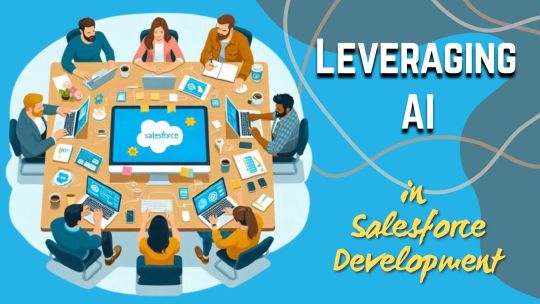
Leveraging AI in Salesforce Development
Artificial Intelligence (AI) is revolutionizing Salesforce development by infusing intelligence into traditional CRM processes. AI allows Salesforce to evolve from a static data management platform into a dynamic, insight-driven system that can predict, recommend, and automate key functions. With AI, Salesforce development is now more about building solutions that are not just reactive but proactive.
Know more at: https://www.cyberswift.com/blog/leveraging-ai-in-salesforce-development/
#generative ai in salesforce#salesforce ai cloud#salesforce einstein gpt#ai-powered crm solutions#bill cipher#salesforce automation with ai#predictive analytics in salesforce#ai-driven customer insights#ai-enhanced salesforce workflows#salesforce lightning and ai integration#chatbots and salesforce crm#salesforce consulting services#salesforce crm solutions#custom salesforce development#salesforce lightning development#salesforce app development#salesforce api integration#salesforce cloud services#salesforce automation solutions#salesforce migration services#salesforce support and maintenance#low-code salesforce development#ai-powered salesforce solutions#iot integration with salesforce#salesforce blockchain integration
1 note
·
View note
Text
Generative AI for Startups: 5 Essential Boosts to Boost Your Business
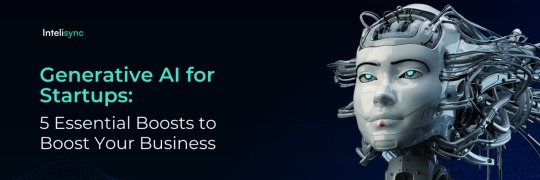
The future of business growth lies in the ability to innovate rapidly, deliver personalized customer experiences, and operate efficiently. Generative AI is at the forefront of this transformation, offering startups unparalleled opportunities for growth in 2024.
Generative AI is a game-changer for startups, significantly accelerating product development by quickly generating prototypes and innovative ideas. This enables startups to innovate faster, stay ahead of the competition, and bring new products to market more efficiently. The technology also allows for a high level of customization, helping startups create highly personalized products and solutions that meet specific customer needs. This enhances customer satisfaction and loyalty, giving startups a competitive edge in their respective industries.
By automating repetitive tasks and optimizing workflows, Generative AI improves operational efficiency, saving time and resources while minimizing human errors. This allows startups to focus on strategic initiatives that drive growth and profitability. Additionally, Generative AI’s ability to analyze large datasets provides startups with valuable insights for data-driven decision-making, ensuring that their actions are informed and impactful. This data-driven approach enhances marketing strategies, making them more effective and personalized.
Intelisync offers comprehensive AI/ML services that support startups in leveraging Generative AI for growth and innovation. With Intelisync’s expertise, startups can enhance product development, improve operational efficiency, and develop effective marketing strategies. Transform your business with the power of Generative AI—Contact Intelisync today and unlock your Learn more...
#5 Powerful Ways Generative AI Boosts Your Startup#advanced AI tools support startups#Driving Innovation and Growth#Enhancing Customer Experience#Forecasting Data Analysis and Decision-Making#Generative AI#Generative AI improves operational efficiency#How can a startup get started with Generative AI?#Is Generative AI suitable for all types of startups?#marketing strategies for startups#Streamlining Operations#Strengthen Product Development#Transform your business with AI-driven innovation#What is Generative AI#Customized AI Solutions#AI Development Services#Custom Generative AI Model Development.
0 notes
Text
0 notes
Text
artificial intelligence| ai development companies| ai in business| ai for business automation| ai development| artificial intelligence ai| ai technology| ai companies| ai developers| ai intelligence| generative ai| ai software development| top ai companies| ai ops| ai software companies| companies that work on ai| artificial intelligence service providers in india| artificial intelligence companies| customer service ai| ai model| leading ai companies| ai in customer support| ai solutions for small business| ai for business book| basic knowledge for artificial intelligence| matching in artificial intelligence|

#artificial intelligence#ai development companies#ai in business#ai for business automation#ai development#artificial intelligence ai#ai technology#ai companies#ai developers#ai intelligence#generative ai#ai software development#top ai companies#ai ops#ai software companies#companies that work on ai#artificial intelligence service providers in india#artificial intelligence companies#customer service ai#ai model#leading ai companies#ai in customer support#ai solutions for small business#ai for business book#basic knowledge for artificial intelligence#matching in artificial intelligence
1 note
·
View note
Text
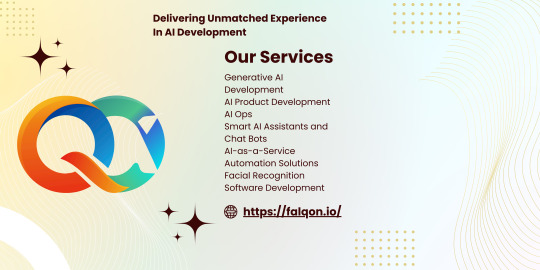
artificial intelligence| ai development companies| ai in business| ai for business automation| ai development| artificial intelligence ai| ai technology| ai companies| ai developers| ai intelligence| generative ai| ai software development| top ai companies| ai ops| ai software companies| companies that work on ai| artificial intelligence service providers in india| artificial intelligence companies| customer service ai| ai model| leading ai companies| ai in customer support| ai solutions for small business| ai for business book| basic knowledge for artificial intelligence| matching in artificial intelligence|
#artificial intelligence#ai development companies#ai in business#ai for business automation#ai development#artificial intelligence ai#ai technology#ai companies#ai developers#ai intelligence#generative ai#ai software development#top ai companies#ai ops#ai software companies#companies that work on ai#artificial intelligence service providers in india#artificial intelligence companies#customer service ai#ai model#leading ai companies#ai in customer support#ai solutions for small business#ai for business book#basic knowledge for artificial intelligence#matching in artificial intelligence
1 note
·
View note